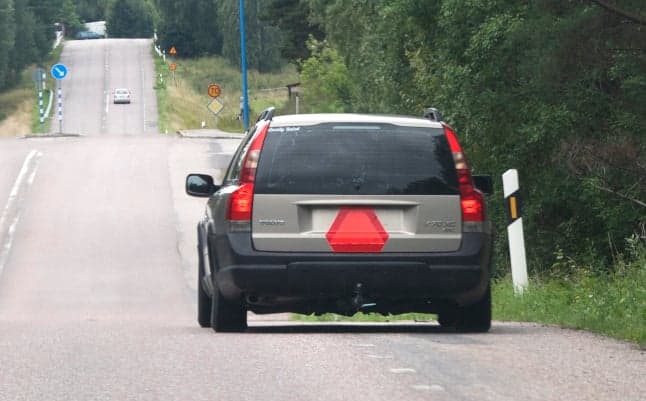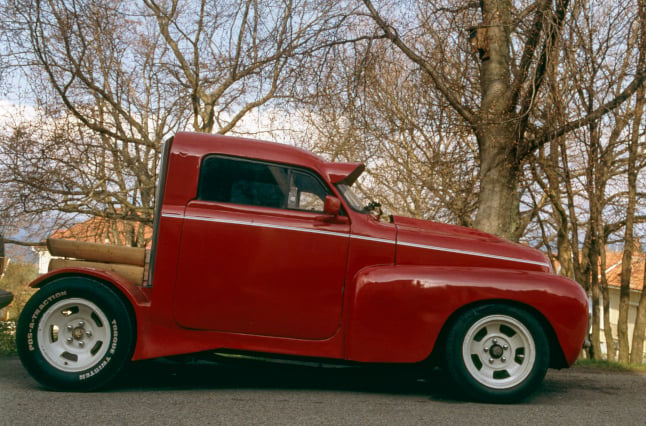Why do Swedish teenagers drive small and excruciatingly slow cars?

If you've spent time in Swedish rural towns, you may have come across groups of teenagers driving small cut-off cars with a max speed of 30km/h and an orange warning triangle on the back. What are they and why do they exist?
These cars are a uniquely Swedish invention, a historical loophole still used today by teenagers who enjoy the freedom they provide – they are officially known as A-traktor (A-tractors), but are also referred to by their older name, EPA-traktor. These cars are more common in rural areas of Sweden – in some municipalities such as Ånge in the Västernorrland region, almost half of all teenagers drive an A-tractor.
Some young A-tractor drivers once explained the reasoning behind their popularity to public broadcaster SVT. "You can get where you want to go without needing a lift, which can be nice on a rainy day. And then there's the community as well," said Isak Ahnlund. "You get to know everyone. You hang out on the weekends, drive EPA, listen to music and meet people," A-tractor owner Estelle Möller told SVT.
The name A-tractor reflects the history of these cars – they were originally developed when agricultural vehicles were in short supply, so the government decided to make it legal to alter standard cars so they were able to be used as tractors.
This is also reflected in the rules for A-tractors which still apply today – they have a maximum speed of 30km/h, cannot have a back seat (hence their cut-off appearance) and must be able to tow agricultural equipment or other vehicles. The gearbox is also limited, meaning that the driver can only use first and second gear.
The orange warning triangle on the back, signalling the limited speed of the vehicle, is called a LGF-skylt; LGF is an acronym of långsamtgående fordon, or slow-moving vehicle.
Nowadays, they are less popular as agricultural vehicles and more popular as cars for teenagers – anyone over the age of 15 can drive one as long as they have a moped or tractor driving licence. The minimum age for a normal driving licence allowing you to drive a car is 18 in Sweden, which is why you'll rarely see adults driving one of these vehicles.
Many of them are hand-built or hand-altered from standard cars, meaning that they are often personalised to the owner, with colours, decorations or decals reflecting the owner's personality. They are also notorious for having loud stereo systems, sometimes leading to complaints from locals tired of listening to teenagers allegedly driving dangerously and playing loud music.

An EPA-tractor in 1990. Photo: Leif R Jansson/TT
An increase in injuries in accidents involving A-tractors last summer has brought them to the top of the agenda, with the Swedish government asking the Transport Agency to investigate whether the rules should be altered.
The Transport Agency will investigate whether there is a need for stricter safety requirements for A-tractors, as well as looking at the possibility of introducing new rules or standards to make them harder to manipulate. A change to their maximum speed limit may also be discussed, from a safety and climate perspective.
Comments (2)
See Also
These cars are a uniquely Swedish invention, a historical loophole still used today by teenagers who enjoy the freedom they provide – they are officially known as A-traktor (A-tractors), but are also referred to by their older name, EPA-traktor. These cars are more common in rural areas of Sweden – in some municipalities such as Ånge in the Västernorrland region, almost half of all teenagers drive an A-tractor.
Some young A-tractor drivers once explained the reasoning behind their popularity to public broadcaster SVT. "You can get where you want to go without needing a lift, which can be nice on a rainy day. And then there's the community as well," said Isak Ahnlund. "You get to know everyone. You hang out on the weekends, drive EPA, listen to music and meet people," A-tractor owner Estelle Möller told SVT.
The name A-tractor reflects the history of these cars – they were originally developed when agricultural vehicles were in short supply, so the government decided to make it legal to alter standard cars so they were able to be used as tractors.
This is also reflected in the rules for A-tractors which still apply today – they have a maximum speed of 30km/h, cannot have a back seat (hence their cut-off appearance) and must be able to tow agricultural equipment or other vehicles. The gearbox is also limited, meaning that the driver can only use first and second gear.
The orange warning triangle on the back, signalling the limited speed of the vehicle, is called a LGF-skylt; LGF is an acronym of långsamtgående fordon, or slow-moving vehicle.
Nowadays, they are less popular as agricultural vehicles and more popular as cars for teenagers – anyone over the age of 15 can drive one as long as they have a moped or tractor driving licence. The minimum age for a normal driving licence allowing you to drive a car is 18 in Sweden, which is why you'll rarely see adults driving one of these vehicles.
Many of them are hand-built or hand-altered from standard cars, meaning that they are often personalised to the owner, with colours, decorations or decals reflecting the owner's personality. They are also notorious for having loud stereo systems, sometimes leading to complaints from locals tired of listening to teenagers allegedly driving dangerously and playing loud music.

An increase in injuries in accidents involving A-tractors last summer has brought them to the top of the agenda, with the Swedish government asking the Transport Agency to investigate whether the rules should be altered.
The Transport Agency will investigate whether there is a need for stricter safety requirements for A-tractors, as well as looking at the possibility of introducing new rules or standards to make them harder to manipulate. A change to their maximum speed limit may also be discussed, from a safety and climate perspective.
Join the conversation in our comments section below. Share your own views and experience and if you have a question or suggestion for our journalists then email us at [email protected].
Please keep comments civil, constructive and on topic – and make sure to read our terms of use before getting involved.
Please log in here to leave a comment.